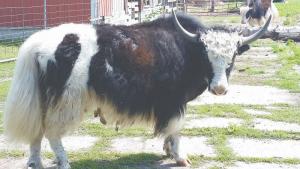2016 - Volume #40, Issue #3, Page #07
[ Sample Stories From This Issue | List of All Stories In This Issue | Print this story
| Read this issue]
Yaks Paying Off For This Small Farm
 |
“I read articles about yak, visited with producers, and bought some meat to see how it tasted,” says Dischinger. “It was the best red meat I’d ever had, so that pretty much sold me.”
After discussing the venture with his family and others, the Dischingers bought 5 Royal Tibetan yak cows and a bull for their breeding stock. Royal yaks look like Holstein cattle. All were registered with the International Yak Association (IYAK).
Dischinger says, “When I unloaded them from the trailer, they walked up to the fence where my beef cows were and stood side-by-side, like they were introducing themselves.” The 600 to 900-lb. females and 1,400-lb. bull had made new friends with the beef cattle, even though their appearance and body structure is quite different.
Dischinger says both male and female yaks have horns, with each set different from the other. He can identify his animals by the shape and length of their horns. Their hair coat is extremely long, they have a slight shoulder hump and a short tail with very long hair. Yaks also have a “skirt” of long hair that grows from their belly. Yak cows have a small udder with 4 teats tucked high between their legs. Calves nurse within an hour of birth and can walk and run a few hours later. Dischinger says they’re slowly taming their herd and a few of the juvenile animals are like oversized St. Bernard dogs. “They’ll wag their tail when we pet them and scratch them behind their ears.”
Dischinger says the best part of raising yaks is that they only eat 1/3 to 1/2 as much as an adult beef cow. They thrive on grass/alfalfa hay and don’t require grain. Originally bred and raised in the high mountains of Tibet, a yak’s stomach gains ample nutrients from lower quality forage than beef cattle. Dischinger has 11 mature yaks on about 4 acres of pasture and also feeds them a 20 percent protein range cube supplement. He says “the cost of feeding and raising yaks is less than half that of beef cattle, and the income opportunities are growing.”
Yak meat was the biggest selling point for Dischinger because of its taste and leanness. It’s naturally 94 to 97 percent lean with texture similar to beef, but a sweeter taste. Dischinger sells ground yak for $10 a lb., yak hamburger patties for $10.50 a lb., and yak summer sausage for $16 a lb. Steaks will be harvested from the steers. A 1,000-lb. yak yields about 550 lbs. of meat, which is production similar to that of a beef steer. A yak calf will grow to a full size animal for harvesting in about 3 1/2 years. Females raised for breeding will have their first calf at about 3 1/2 years.
Another source of income from a yak is its cashmere-like fiber. Dischinger harvests fiber from his animals by combing them with a dog brush 5 to 7 times from April to July. Young animals produce about 1 lb. of fiber and older animals produce less due to their subcutaneous fat layer. Dischinger has the fiber processed into skeins of yarn. White fiber sells for $8 an ounce and black fiber sells for $4 an ounce. They plan on producing yak hide rugs and blankets, yak leather chopper mittens with yak fiber liners, hats and scarves. Cleaned skulls and bones can also be sold.
“I’ve loved every minute of yak farming and wish I would’ve discovered them sooner,” Dischinger says. “They’re very unique animals, easy to raise, aren’t affected much by the heat or cold and are very friendly when they’ve had a lot of human interaction. Another big plus is that when calves are weaned the cows and calves don’t make a lot of noise like beef animals. A yak just produces a barely audible grunting sound.”
Contact: FARM SHOW Followup, Craig Dischinger, Hot Disch Farm, LLC, 12001 Hwy. 23 S.W., Raymond, Minn. 56282 (ph 320 420-4012; cdischinger@gmail.com).

Click here to download page story appeared in.

Click here to read entire issue
To read the rest of this story, download this issue below or click here to register with your account number.




